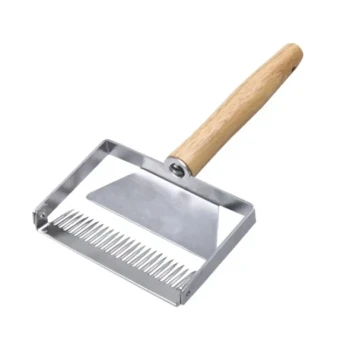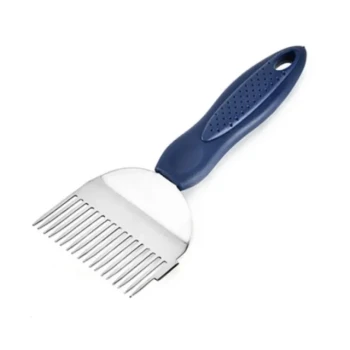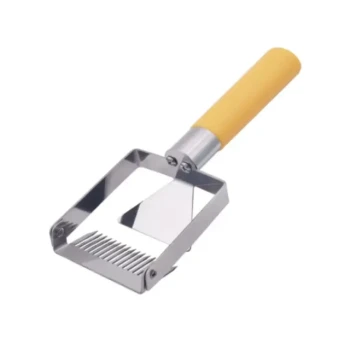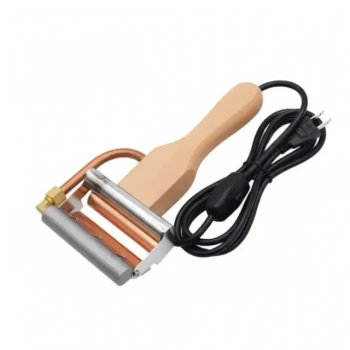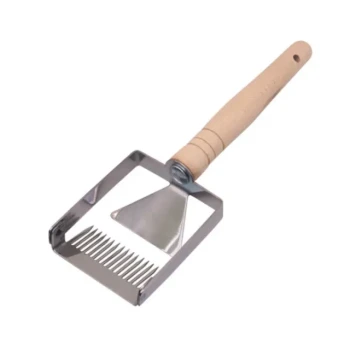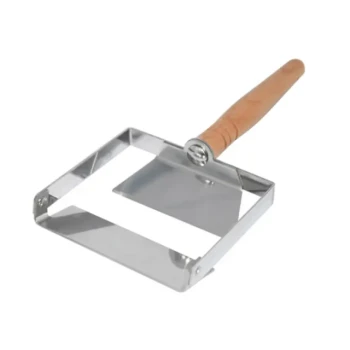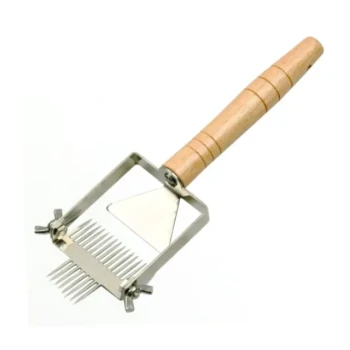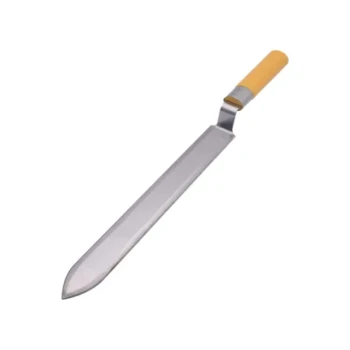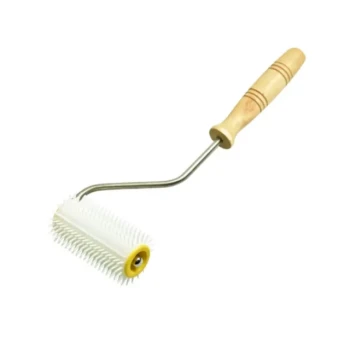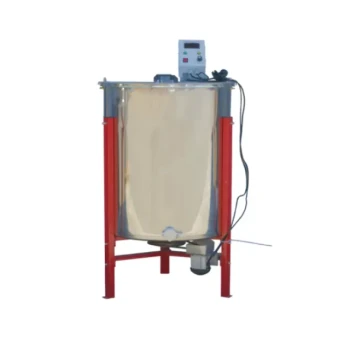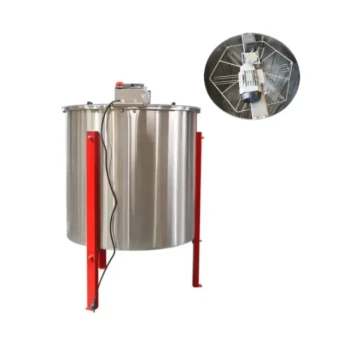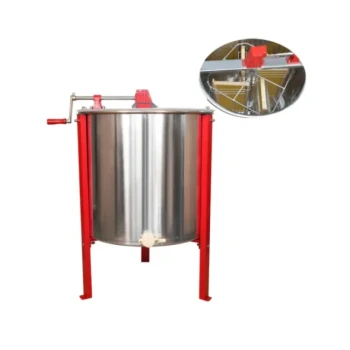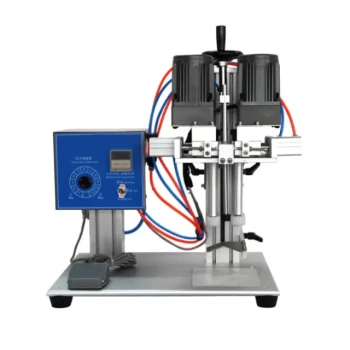For most beekeepers, the right size uncapping tank is determined entirely by the number of hives you manage. Beginners with one or two hives can start effectively with a simple 5-gallon bucket, while those with larger apiaries will benefit from dedicated tanks designed to handle a higher volume of frames and cappings.
The core principle is to match your equipment to your workflow. A tank that is too small creates a bottleneck during extraction, while one that is too large is an unnecessary expense and a waste of space.
Matching Your Tank to Your Apiary Size
The volume of honey you harvest at one time is the single most important factor in choosing an uncapping tank. This is directly related to the number of hives in your apiary.
For the Small-Scale Hobbyist (1-3 Hives)
At this scale, your primary concerns are cost and simplicity. A dedicated uncapping tank is often unnecessary.
A system using two food-grade 5- or 6-gallon buckets is the standard and most economical choice. One bucket, fitted with a sieve or filter, is placed inside the other to allow the honey from the cappings to drain through.
This setup is sufficient to handle the cappings from a few hives without a significant investment in specialized equipment.
For the Growing Beekeeper (4-10 Hives)
Once you manage four or more hives, the bucket system becomes a point of frustration. The volume of cappings and dripping honey quickly overwhelms a small bucket, creating a sticky and inefficient workflow.
This is the ideal stage to invest in a dedicated uncapping tank. These are typically purpose-built plastic or stainless steel tubs with a grid to hold cappings and a honey gate at the bottom to drain the salvaged honey.
Look for a tank that can comfortably hold the cappings from at least one full super (8-10 frames) at a time. This allows you to work in batches without constantly stopping to empty the container.
For the Sideliner Operation (10+ Hives)
With ten or more hives, efficiency is paramount. Harvesting becomes a multi-day process, and your equipment must support a high-volume workflow.
At this level, you should consider a large, long-format stainless steel tank. These tanks are designed to hold multiple frames for uncapping and can accommodate the cappings from dozens of supers.
They often feature integrated frame rests and are large enough to be a central part of an efficient extraction line, feeding directly into your extractor and honey sump.
Understanding the Trade-offs
Choosing the right tank involves balancing cost, convenience, and the physical space you have available.
The Cost vs. Efficiency Balance
A bucket setup costs very little but is slow and messy for larger harvests. A dedicated stainless steel tank is a significant investment but can save you hours of work and frustration, while also maximizing your honey recovery.
Material: Plastic vs. Stainless Steel
Food-grade plastic tanks are an excellent mid-range option. They are lightweight, affordable, and easy to handle.
Stainless steel is the premium choice. It is exceptionally durable, will not be damaged by uncapping knives, and is the easiest material to clean and keep sanitary over many years of use.
The Space Commitment
Consider where you will store your equipment. A bucket system is compact and easy to store. A large uncapping tank requires significant dedicated space in a garage or workshop, a factor that should not be overlooked.
Making the Right Choice for Your Scale
Your goal dictates your equipment. Let your current and near-future apiary size be your guide.
- If your primary focus is keeping 1-3 hives: Start with a simple and effective two-bucket system to minimize cost and storage needs.
- If your primary focus is managing 4-10 hives: Invest in a medium-sized, dedicated uncapping tank to dramatically improve your extraction day efficiency.
- If your primary focus is a sideliner business with 10+ hives: Choose a large stainless steel tank that can serve as the durable centerpiece of your entire honey processing setup.
Ultimately, selecting the right uncapping tank is about choosing the tool that makes your harvest day smoother and more enjoyable.
Summary Table:
| Apiary Size | Recommended Tank | Key Features |
|---|---|---|
| 1-3 Hives | 5-Gallon Bucket System | Low cost, simple, easy to store |
| 4-10 Hives | Dedicated Plastic/Stainless Steel Tank | Handles 8-10 frames, includes honey gate |
| 10+ Hives | Large Stainless Steel Tank | Durable, efficient for high-volume extraction |
Upgrade Your Harvest Efficiency with HONESTBEE
Choosing the right uncapping tank is crucial for a smooth and productive honey harvest. Whether you're a commercial apiary managing hundreds of hives or a beekeeping equipment distributor, HONESTBEE has the durable, high-performance supplies you need. We supply a full range of uncapping tanks, from efficient plastic models to premium stainless steel workhorses, designed to maximize your honey recovery and workflow efficiency.
Let our wholesale-focused expertise help you build a more profitable operation. Contact our team today to discuss your specific needs and get a quote on the best equipment for your scale.
Related Products
- Automatic Honey Frame Uncapper Machine for Beekeeping
- Extra Wide Stainless Steel Honey Uncapping Fork with Scraper Beekeeping Tool
- Professional Multi-Function Uncapping Fork with Integrated Blade for Beekeeping
- Stainless Steel Pivoting Honey Uncapping Fork with Plastic Handle
- Electric Adjustable Blade Honey Uncapping Plane
People Also Ask
- What is the typical frame capacity of manual honey extractors? Ideal for Small-Scale Beekeepers
- What is a method for harvesting honey from foundationless frames using an extractor? A Step-by-Step Guide
- Can honey extractors accommodate different frame sizes? A Guide to Choosing the Right Extractor
- How to uncap and extract honey? A Beekeeper's Guide to a Clean, Efficient Harvest
- What are tangential honey extractors and what are their features? A Guide for Small-Scale Beekeepers

